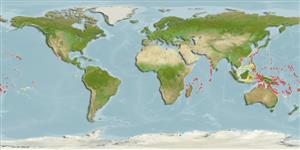Preferred temperature (Ref.
123201): 24.9 - 29.3, mean 28 °C (based on 1657 cells).
Phylogenetic diversity index (Ref.
82804): PD
50 = 0.5000 [Uniqueness, from 0.5 = low to 2.0 = high].
Bayesian length-weight: a=0.01023 (0.00477 - 0.02194), b=3.01 (2.83 - 3.19), in cm total length, based on LWR estimates for this (Sub)family-body shape (Ref.
93245).
Niveau trophique (Ref.
69278): 3.1 ±0.3 se; based on size and trophs of closest relatives
Résilience (Ref.
120179): Haut, temps minimum de doublement de population inférieur à 15 mois (Preliminary K or Fecundity.).
Fishing Vulnerability (Ref.
59153): Low vulnerability (10 of 100).
Nutrients (Ref.
124155): Calcium = 357 [158, 1,048] mg/100g; Iron = 1.62 [0.73, 3.39] mg/100g; Protein = 18.1 [16.0, 19.9] %; Omega3 = 0.165 [0.057, 0.438] g/100g; Selenium = 27.1 [9.3, 68.8] μg/100g; VitaminA = 126 [29, 564] μg/100g; Zinc = 4.13 [2.34, 6.66] mg/100g (wet weight);
